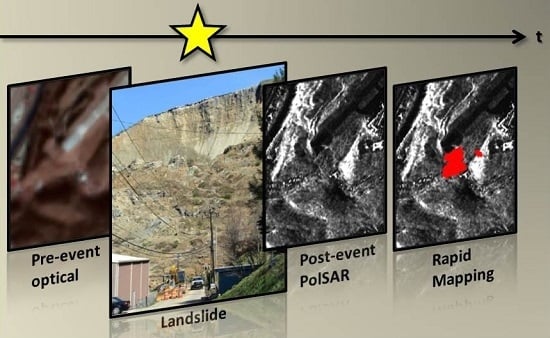Landslide Mapping in Vegetated Areas Using Change Detection Based on Optical and Polarimetric SAR Data
Abstract
:1. Introduction
2. Study Sites and Data
3. Method
3.1. Pre-Event Imagery: Selection of Vegetated Areas
3.2. Post-Event Imagery: Selection of Bare Areas
3.2.1. Polarimetric Speckle Filtering
3.2.2. Polarimetric Decomposition
3.3. Change Detection: Mapping of the Landslides
3.4. Refinement of Classification by Topographic Information
4. Results and Discussion
4.1. The Yeager Airport Landslide, Charleston, West Virginia, USA
4.2. Mining Waste Landslide near Bolshaya Talda, Kemerovo Oblast, Russia
4.3. General Discussion
5. Conclusions
- The utilization of SAR imagery allows fast response in a crisis situation due to the day/night availability and almost complete weather independency of the SAR system. As heavy rain events are an important trigger for landslides, optical sensors, relying on a cloud-free sky to be able to provide a useful imagery are, in many cases, not suited.
- The presented methodology requires only freely-available and systematically-acquired pre-event optical high resolution imagery and post-event VHR PolSAR imagery. Other landslide mapping procedures, which are based on change detection using SAR imagery, require pre- and post-event VHR SAR imagery. However, the VHR archive SAR imagery acquired shortly before a landslide event are, in most cases, not available. This is especially true when a certain imaging geometry is required determined by the next possible SAR acquisition over the crisis area. Modern VHR SAR missions, such as COSMO-SkyMed, TerraSAR-X, or RADARSAT-2 do not systematically cover the entire Earth’s landmass.
- The methodology proposed in this article is also based on change detection. However, high-resolution optical imagery of Landsat-8 or Sentinel-2 is used as pre-event information. As these imagery are freely available and systematically acquired on the entire Earth’s landmass at high repetition rates (cf. Section 3.1), it is guaranteed that useful, i.e., cloud-free, pre-event imagery is available for the entire Earth’s landmass. In the ideal case, the optical imagery is acquired shortly before the landslide event. However, in cases where cloud coverage is too high, cloud-free optical imagery acquired at the same season one year before could be used.
Supplementary Materials
Acknowledgments
Author Contributions
Conflicts of Interest
Abbreviations
| ALOS | Advanced Land Observing Satellite |
| CNL | Cognition Network Language |
| DEM | Digital Elevation Model |
| DLR | German Aerospace Center |
| EMAS | Engineered Material Arrestor System |
| EO | Earth Observation |
| FAA | Federal Aviation Administration |
| FNEA | Fractal Net Evolution Approach |
| HR | High Resolution |
| HS | HighResolution SpotLight |
| InSAR | Synthetic Aperature Radar Interferometry |
| LiDAR | Light Detection And Ranging |
| MS | Multispectral |
| NDVI | Normalized Difference Vegetation Index |
| NIR | Near-Infra-Red |
| OA | Overall Accuracy |
| OBIA | Object-Based Image Analysis |
| PA | Producer’s Accuracy |
| PALSAR | Phased Array type L-band Synthetic Aperture Radar |
| PolSAR | Polarimetric Synthetic Aperture Radar |
| RVI | Radar Vegetation Index |
| SAR | Synthetic Aperture Radar |
| SRTM | Shuttle Radar Topography Mission |
| UA | User’s Accuracy |
| USGS | United States Geological Survey |
| VHR | Very High Resolution |
References
- Petley, D. Global patterns of loss of life from landslides. Geology 2012, 40, 927–930. [Google Scholar] [CrossRef]
- Voigt, S.; Kemper, T.; Riedlinger, T.; Kiefl, R.; Scholte, K.; Mehl, H. Satellite image analysis for disaster and crisis-management support. IEEE Trans. Geosci. Remote Sens. 2007, 45, 1520–1528. [Google Scholar] [CrossRef]
- Singleton, A.; Li, Z.; Hoey, T.; Muller, J.-P. Evaluating sub-pixel offset techniques as an alternative to D-InSAR for monitoring episodic landslide movements in vegetated terrain. Remote Sens. Environ. 2014, 147, 133–144. [Google Scholar] [CrossRef]
- Cruden, D.M.; Varnes, D.J. Landslides Types and Processes. In Landslides: Investigation and Mitigation. Special Report 247, Transportation Research Board, National Research Council; Turner, A.K., Schuster, R.L., Eds.; National Academy Press: Washington, DC, USA, 1996; pp. 36–75. [Google Scholar]
- Manconi, A.; Casu, F.; Ardizzone, F.; Bonano, M.; Cardinali, M.; de Luca, C.; Gueguen, E.; Marchesini, I.; Parise, M.; Vennari, C.; et al. Brief Communication: Rapid mapping of landslide events: The 3 December 2013 Montescaglioso landslide, Italy. Nat. Hazards Earth Syst. Sci. 2014, 14, 1835–1841. [Google Scholar] [CrossRef]
- Tralli, D.M.; Blom, R.G.; Zlotnicki, V.; Donnellan, A.; Evans, D.L. Satellite remote sensing of earthquake, volcano, flood, landslide and coastal inundation hazards. ISPRS J. Photogramm. Remote Sens. 2005, 59, 185–198. [Google Scholar] [CrossRef]
- Scainoi, M.; Longoni, L.; Melillo, V.; Papini, M. Remote Sensing for Landslide Investigations: An Overview of Recent Achievements and Perspectives. Remote Sens. 2014, 6, 9600–9652. [Google Scholar] [CrossRef]
- Joyce, K.E.; Samsonov, S.V.; Levick, S.R.; Engelbrecht, J.; Belliss, S. Mapping and monitoring geological hazards using optical, LiDAR, and synthetic aperture RADAR image data. Nat. Hazards 2014, 73, 137–163. [Google Scholar] [CrossRef]
- Martha, T.R.; Kerle, N.; Jetten, V.; van Westen, C.J.; Kumar, K.V. Characterising spectral, spatial and morphometric properties of landslides for semi-automatic detection using object-oriented methods. Geomorphology 2010, 116, 24–36. [Google Scholar] [CrossRef]
- Mondini, A.C.; Chang, K.-T.; Yin, H.-Y. Combining multiple change detection indices for mapping landslides triggered by typhoons. Geomorphology 2011, 134, 440–451. [Google Scholar] [CrossRef]
- Behling, R.; Roessner, S.; Segl, K.; Kleinschmit, B.; Kaufmann, H. Robust Automated Image Co-Registration of Optical Multi-Sensor Time Series Data: Database Generation for Multi-Temporal Landslide Detection. Remote Sens. 2014, 6, 2572–2600. [Google Scholar] [CrossRef]
- Behling, R.; Roessner, S.; Kaufmann, H.; Kleinschmit, B. Automated Spatiotemporal Landslide Mapping over Large Areas Using RapidEye Time Series Data. Remote Sens. 2014, 6, 8026–8055. [Google Scholar] [CrossRef]
- Hölbling, D.; Füreder, P.; Antolini, F.; Cigna, F.; Casagli, N.; Lang, S. A Semi-Automated Object-Based Approach for Landslide Detection Validated by Persistent Scatterer Interferometry Measures and Landslide Inventories. Remote Sens. 2012, 4, 1310–1336. [Google Scholar] [CrossRef]
- Othman, A.A.; Gloaguen, R. Automatic Extraction and Size Distribution of Landslides in Kurdistan Region, NE Iraq. Remote Sens. 2013, 5, 2389–2410. [Google Scholar] [CrossRef]
- Mondini, A.C.; Guzzetti, F.; Reichenbach, P.; Rossi, M.; Cardinali, M.; Ardizzone, F. Semi-automatic recognition and mapping of rainfall induced shallow landslides using optical satellite images. Remote Sens. Environ. 2011, 7, 1743–1775. [Google Scholar] [CrossRef]
- Shibayama, T.; Yamaguchi, Y. An application of polarimetric radar analysis on geophysical phenomena. In Proceedings of the IEEE IGARSS, Melbourne, Australia, 21–26 July 2013; pp. 3191–3194.
- Shimada, M.; Watanabe, M.; Motooka, T.; Ohki, M.; Wada, Y. PALSAR-2 and Pi-SAR-L2—Multi frequency Polarimetric Sensitivity on Disaster. In Proceedings of the EUSAR Berlin, Germany, 3–5 June 2014; pp. 93–94.
- Plank, S. Rapid Damage Assessment by Means of Multi-Temporal SAR—A Comprehensive Review and Outlook to Sentinel-1. Remote Sens. 2014, 6, 4870–4906. [Google Scholar] [CrossRef]
- McKean, J.; Roering, J. Objective landslide detection and surface morphology mapping using high-resolution airborne laser altimetry. Geomorphology 2004, 57, 331–351. [Google Scholar] [CrossRef]
- Santangelo, M.; Cardinali, M.; Rossi, M.; Mondini, A.C.; Guzzetti, F. Remote landslide mapping using a laser rangefinder binocular and GPS. Nat. Hazards Earth Syst. Sci. 2010, 10, 2539–2546. [Google Scholar] [CrossRef]
- Czuchlewski, K.R.; Weissel, J.K.; Kim, Y. Polarimetric synthetic aperture radar study of the Tsaoling landslide generated by the 1999 Chi-Chi earthquake, Taiwan. J. Geophys. Res. 2003, 108, 6006. [Google Scholar] [CrossRef]
- Christophe, E.; Chai, A.S.; Yin, T.; Kwoh, L.K. 2009 Earthquakes in Sumatra: The Use of L-band Interferometry in a SAR-Hostile Environment. In Proceedings of the IEEE IGARSS, Honolulu, HI, USA, 25–30 July 2010; pp. 1202–1205.
- Kawamura, M.; Tsujino, K.; Tsujiko, Y.; Tanjung, J. Detection Method of Slope Failures Due to the 2009 Sumatra Earthquake by Using TerraSAR-X Images. In Proceedings of the IEEE IGARSS, Vancouver, BC, Canada, 24–29 July 2011; pp. 4292–4295.
- Ferretti, A.; Prati, C.; Rocca, F. Nonlinear Subsidence Rate Estimation Using Permanent Scatterers in Differential SAR Interferometry. IEEE Trans. Geosci. Remote Sens. 2000, 38, 2202–2012. [Google Scholar] [CrossRef]
- Ferretti, A.; Fumagalli, A.; Novali, F.; Prati, C.; Rocca, F.; Rucci, A. A New Algorithm for Processing Interferometric Data-Stacks: SqueeSAR. IEEE Trans. Geosci. Remote Sens. 2011, 49, 3460–3470. [Google Scholar] [CrossRef]
- Berardino, P.; Fornaro, G.; Lanari, R.; Sansosti, E. A new algorithm for surface deformation monitoring based on small baseline differential SAR interferograms. IEEE Trans. Geosci. Remote Sens. 2002, 40, 2375–2383. [Google Scholar] [CrossRef]
- Raspini, F.; Ciampalini, A.; Del Conte, S.; Lombardi, L.; Nocentini, M.; Gigli, G.; Ferretti, A.; Casagli, N. Exploitation of Amplitude and Phase of Satellite SAR Images for Landslide Mapping: The Case of Montescaglioso (South Italy). Remote Sens. 2015, 7, 14576–14596. [Google Scholar] [CrossRef]
- Ainsworth, T.L.; Kelly, J.P.; Lee, J.S. Classification comparisons between dual-pol, compact polarimetric and quad-pol SAR imagery. ISPRS J. Photogramm. Remote Sens. 2009, 64, 464–471. [Google Scholar] [CrossRef]
- Rodriguez, K.M.; Weissel, J.K.; Kim, Y. Classification of Landslide Surfaces Using Fully Polarimetric SAR: Examples from Taiwan. In Proceedings of the IEEE IGARSS, Toronto, Canada, 24–28 July 2002; pp. 2918–2920.
- Cui, M.; Prasad, S.; Mahrooghy, M.; Aastoos, J.V.; Lee, M.A.; Bruce, L.M. Decision Fusion of Textural Features Derived From Polarimetric Data for Levee Assessment. IEEE J-STARS 2012, 5, 970–976. [Google Scholar] [CrossRef]
- Plank, S.; Hölbling, D.; Eisank, C.; Friedl, B.; Martinis, S.; Twele, A. Comparing object-based landslide detection methods based on polarimetric SAR and optical satellite imagery—A case study in Taiwan. In Proceedings of the 7th International Workshop on Science and Applications of SAR Polarimetry and Polarimetric Interferometry, POLinSAR 2015, Frascati, Italy, 26–30 January 2015; p. 5.
- Freeman, A.; Durden, S.L. A three-component scattering model for polarimetric SAR data. IEEE Trans. Geosci. Remote Sens. 1998, 36, 963–973. [Google Scholar] [CrossRef]
- Yamaguchi, Y.; Moriyama, T.; Ishido, M.; Yamada, H. Four-component scattering model for polarimetric SAR image decomposition. IEEE Trans. Geosci. Remote Sens. 2005, 43, 1699–1706. [Google Scholar] [CrossRef]
- Yamaguchi, Y.; Sato, A.; Boener, W.-M.; Sato, R.; Yamada, H. Four-Component Scattering Power Decomposition with Rotation of Coherency Matrix. IEEE Trans. Geosci. Remote Sens. 2011, 49, 2251–2258. [Google Scholar] [CrossRef]
- Watanabe, M.; Yonezawa, C.; Iisaka, J.; Sato, M. ALOS/PALSAR full polarimetric observations of the Iwate-Miyagi Nairiku earthquake of 2008. Int. J. Remote Sens. 2012, 33, 1234–1245. [Google Scholar] [CrossRef]
- Yamaguchi, Y. Disaster Monitoring by Fully Polarimetric SAR Data Acquired With ALOS-PALSAR. IEEE Proc. 2012, 100, 2851–2860. [Google Scholar] [CrossRef]
- Shibayama, T.; Yamaguchi, Y. A landslide detection based on the change of scattering power components between multi-temporal PolSAR data. In Proceedings of the IEEE IGARSS, Quebec, Canada, 13–18 July 2014; pp. 2734–2737.
- Shibayama, T.; Yamaguchi, Y.; Yamada, H. Polarimetric Scattering Properties of Landslides in Forested Areas and the Dependence on the Local Incidence Angle. Remote Sens. 2015, 7, 15424–15442. [Google Scholar] [CrossRef]
- Yonezawa, C.; Watanabe, M.; Saito, G. Polarimetric decomposition analysis of ALOS PALSAR observation data before and after a landslide event. Remote Sens. 2012, 4, 2314–2328. [Google Scholar] [CrossRef]
- Cloude, S.R.; Pottier, E. An entropy based classification scheme for land applications of polarimetric SAR. IEEE Trans. Geosci. Remote Sens. 1997, 35, 68–78. [Google Scholar] [CrossRef]
- Charleston Gazette. 22 March 2015. Available online: http://www.wvgazettemail.com/article/20150322/GZ01/150329837 (accessed on 23 March 2015).
- STGEC 2010. Available online: https://stgec.org/presentations/STGEC_2010/2010%20STGEC%20-%20Yeager%20Airport%20-%20Tallest%20Reinforced%20Slope%20in%20N%20America.pdf (accessed on 21 December 2015).
- Petley, D. AGU Landslide Blog. Yeager Airport Landslide. 2015. Available online: http://blogs.agu.org/landslideblog/2015/04/14/yeager-airport-landslide-next/ (accessed on 15 April 2015).
- Charleston Gazette. 12 March 2015. Available online: http://www.wvgazettemail.com/article/20150312/DM05/150319672 (accessed on 13 March 2015).
- Charleston Gazette. 13 March 2015. Available online: http://www.wvgazettemail.com/article/20150313/DM01/150319516/2007062715 (accessed on 14 March 2015).
- Charleston Gazette. 13 April 2015. Available online: http://www.wvgazettemail.com/article/20150413/GZ01/150419806 (accessed on 14 April 2015).
- Petley, D. AGU Landslide Blog. The Bolshaya Talda Earthflow in Russia Was a Mine Waste Failure. 2015. Available online: http://blogs.agu.org/landslideblog/2015/04/20/bolshaya-talda-1/ (accessed on 21 April 2015).
- Lillesand, T.M.; Kiefer, R.W. Remote Sensing and Image Interpretation, 4th ed.; John Wiley & Sons: New York, NY, USA, 2000. [Google Scholar]
- Gupta, R.P. Remote Sensing Geology; Springer: Heidelberg, Germany, 2003. [Google Scholar]
- Albertz, J.; Wiggenhagen, M. Guide for Photogrammetry and Remote Sensing, 5th ed.; Wichmann: Paderborn, Germany, 2009. [Google Scholar]
- Rouse, J.W.; Haas, R.H.; Schell, J.A.; Deering, D.W. Monitoring vegetation systems in the Great Plains with ERTS. In Third Earth Resources Technology Satellite–1 Syposium, Volume I: Technical Presentations, NASA SP-351; Freden, S.C., Mercanti, E.P., Becker, M., Eds.; NASA: Washington, DC, USA, 1974; pp. 309–317. [Google Scholar]
- Lee, J.S. Refined filtering of image noise using local statistics. Comput. Graph. Image Process. 1981, 15, 380–389. [Google Scholar] [CrossRef]
- Lee, J.S.; Jurkevich, I.; Dewaele, P.; Wambacq, P.; Oosterlinck, A. Speckle filtering of synthetic aperture radar images: A review. Remote Sens. Rev. 1994, 8, 313–340. [Google Scholar] [CrossRef]
- Cable, J.W.; Kovacs, J.M.; Shang, J.; Jiao, X. Multi-Temporal polarimetric RADARSAT-2 for land cover monitoring in northeastern Ontario, Canada. Remote Sens. 2014, 6, 2372–2392. [Google Scholar] [CrossRef]
- Qi, Z.; Yeh, A.G.-O.; Li, X.; Lin, Z. A novel algorithm for land use and land cover classification using RADARSAT-2 polarimetric SAR data. Remote Sens. Environ. 2012, 118, 21–39. [Google Scholar] [CrossRef]
- Jagdhuber, T.; Stockamp, J.; Hajnsek, I.; Ludwig, R. Identification of soil freezing and thawing states using SAR polarimetry at C-Band. Remote Sens. 2014, 6, 2008–2023. [Google Scholar] [CrossRef]
- Baatz, M.; Schäpe, A. Object-oriented and multi-scale image analysis in semantic networks. In Proceeding of the 1999 International Symposium on Operationalization of Remote Sensing, Enschede, The Netherlands, 16–20 August 1999.
- Baatz, M.; Schäpe, A. Multiresolution Segmentation: An Optimization Approach for High Quality Multi-Scale Image Segmentation. Available online: http://www.ecognition.com/sites/default/files/technology.pdf (accessed on 12 January 2016).
- Willhauck, G. Comparison of object oriented classification techniques and standard image analysis for the use of change detection between SPOT multispectral satellite images and aerial photos. Int. Arch. Photogramm. Remote Sens. 2000, 33, 214–221. [Google Scholar]
- Rabus, B.; Eineder, M.; Roth, A.; Bamler, R. The shuttle radar topography mission—A new class of digital elevation models acquired by spaceborne radar. ISPRS J. Photogramm. Remote Sens. 2003, 57, 241–261. [Google Scholar] [CrossRef]
- Krieger, G.; Zink, M.; Bachmann, M.; Bräutigam, B.; Schulze, D.; Martone, M.; Rizzoli, P.; Steinbrecher, U.; Antony, J.W.; DeZan, F.; et al. TanDEM-X: A radar interferometer with two formation-flying satellites. Acta Astronautica 2013, 89, 83–98. [Google Scholar] [CrossRef]
- Cohen, J. A coefficient of agreement for nominal scales. Educ. Psychol. Meas. 1960, 20, 37–46. [Google Scholar] [CrossRef]
- Furuta, R.; Sawada, K. Case Study of Landslide Recognition using Dual/Quad Polarization data of ALOS/PALSAR. In Proceedings of the Asia-Pacific Conference on Synthetic Aperture Radar (APSAR), Tsukuba, Japan, 23–27 September 2013; pp. 481–484.
- Plank, S.; Singer, J.; Minet, C.; Thuro, K. Pre-survey suitability evaluation of the differential synthetic aperture radar interferometry method for landslide monitoring. Int. J. Remote Sens. 2012, 33, 6623–6637. [Google Scholar] [CrossRef]
- Dabbiru, L.; Aanstoos, J.V.; Hasan, K.; Younan, N.H.; Li, W. Landslide Detection on Earthen Levees with X-band and L-band Radar Data. In Proceedings of the Applied Imagery Pattern Recognition Workshop Sensing for Control and Augmentation 2013 IEEE (AIPR), Washington, DC, USA, 23–25 October 2013; p. 5.
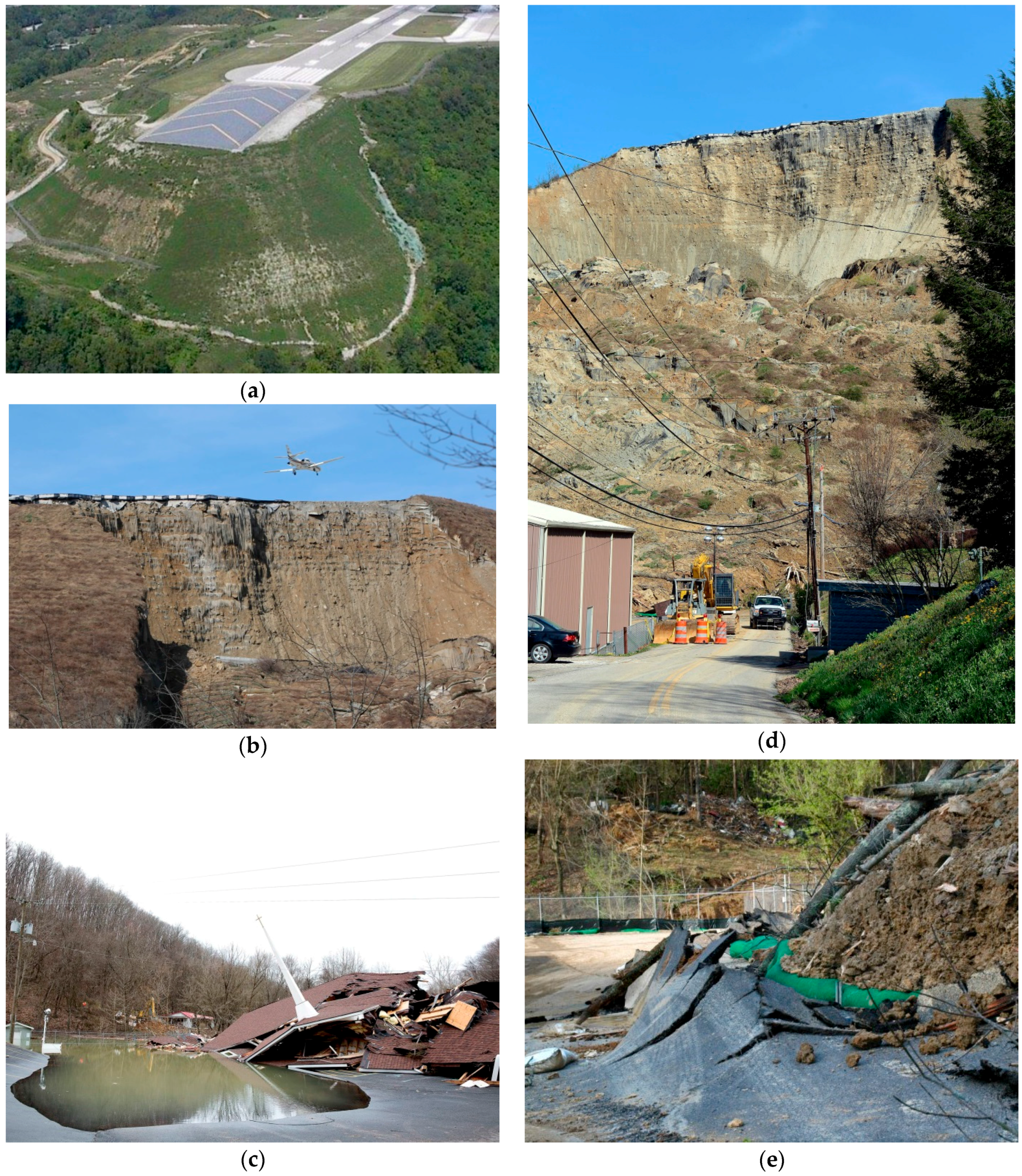
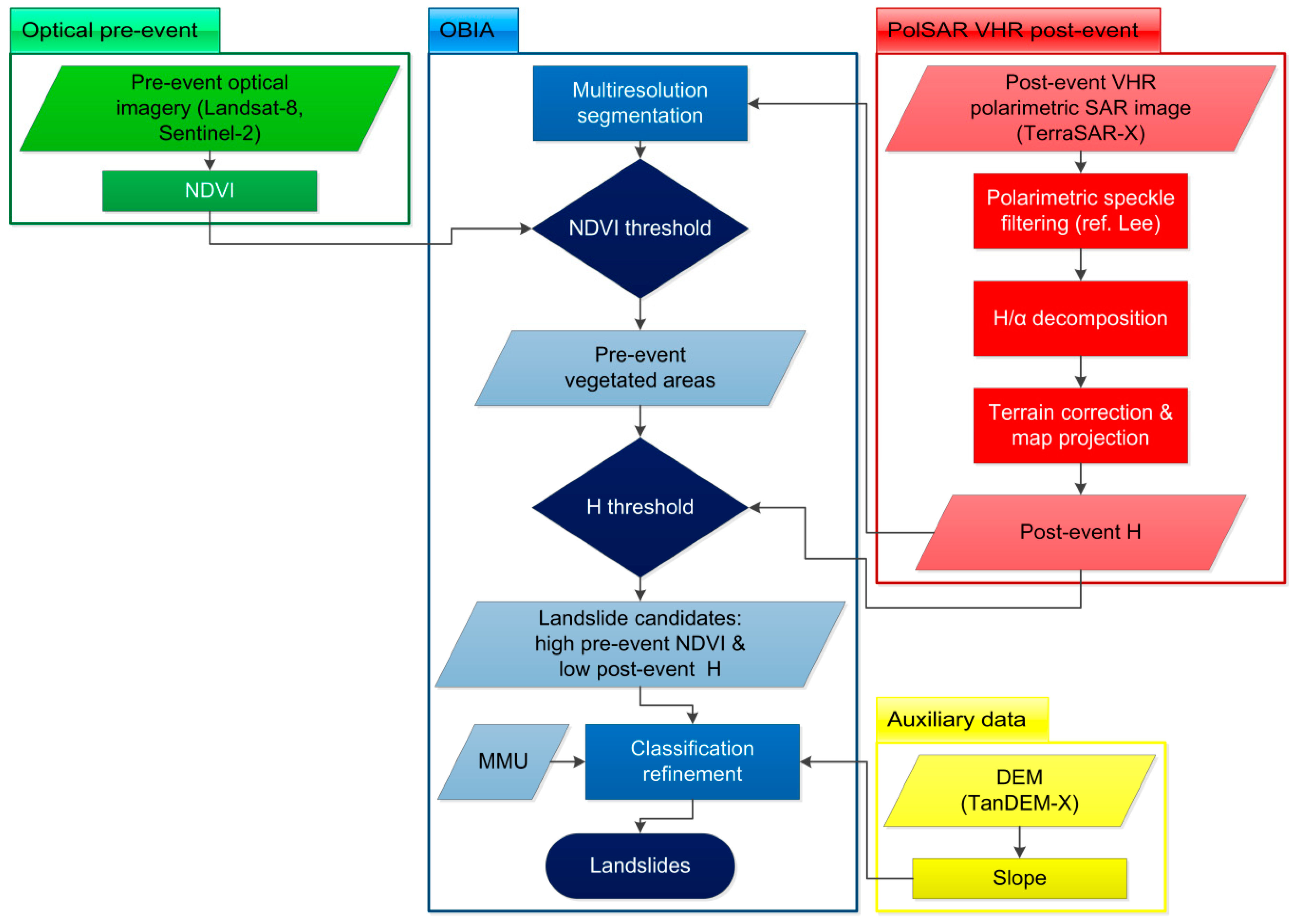
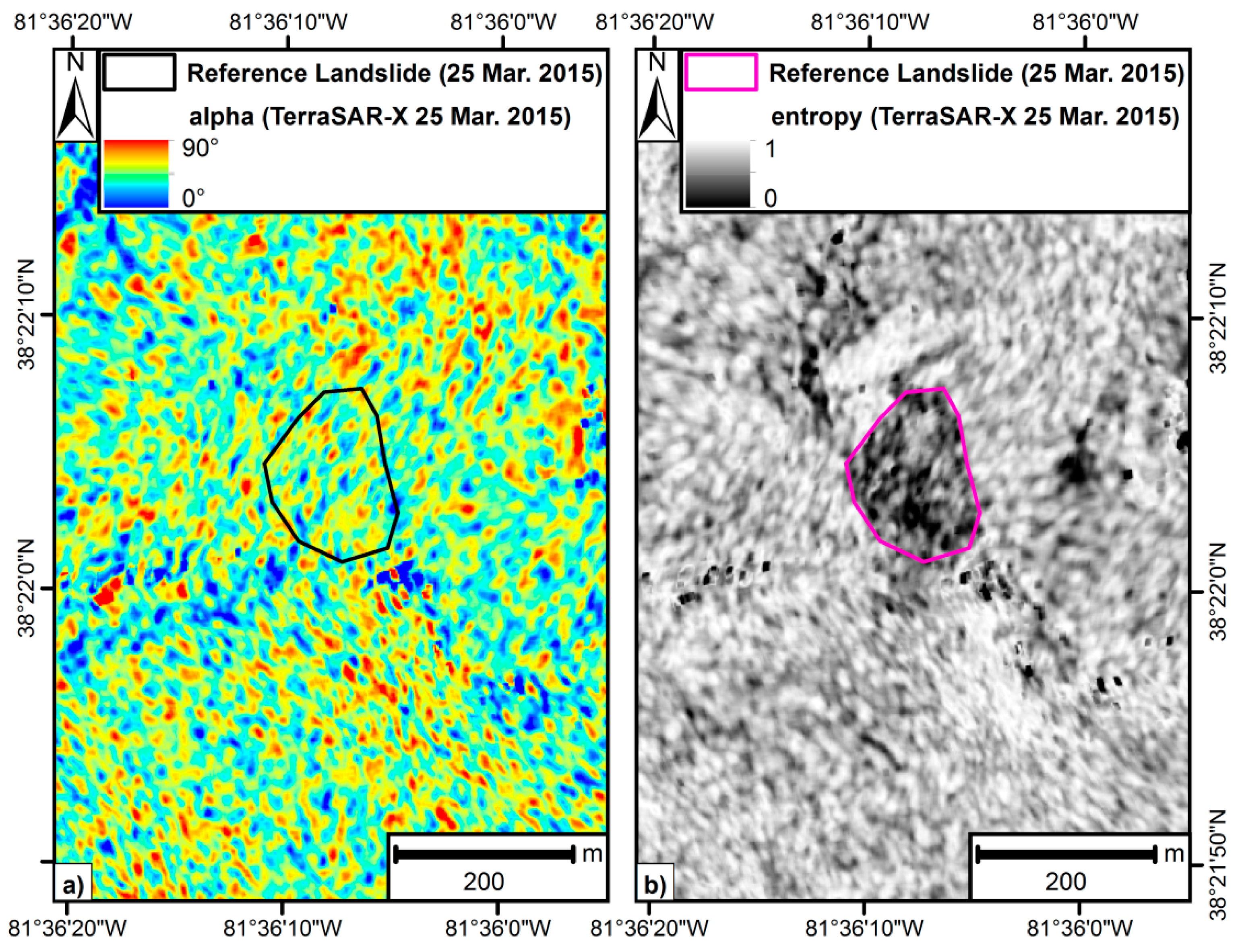
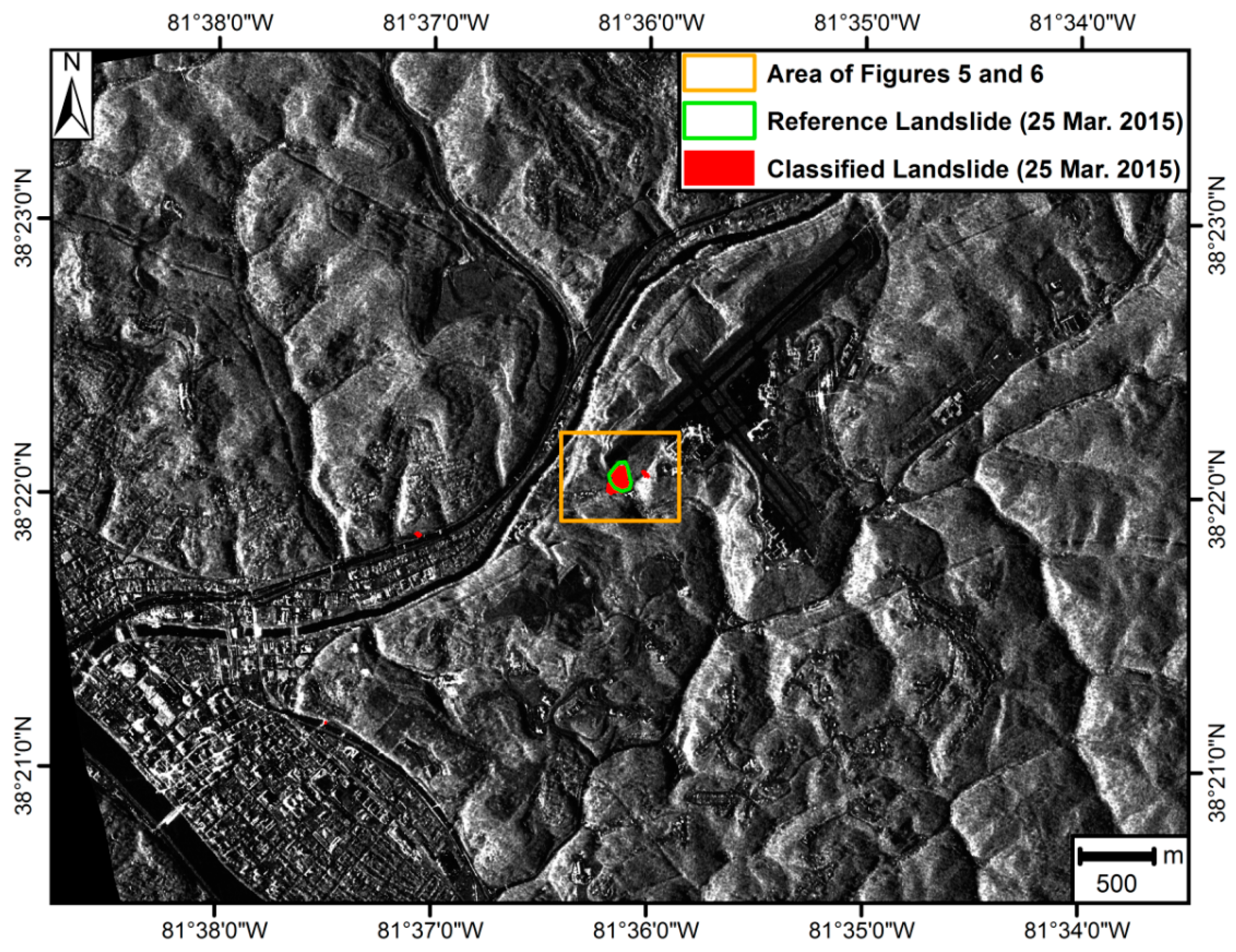
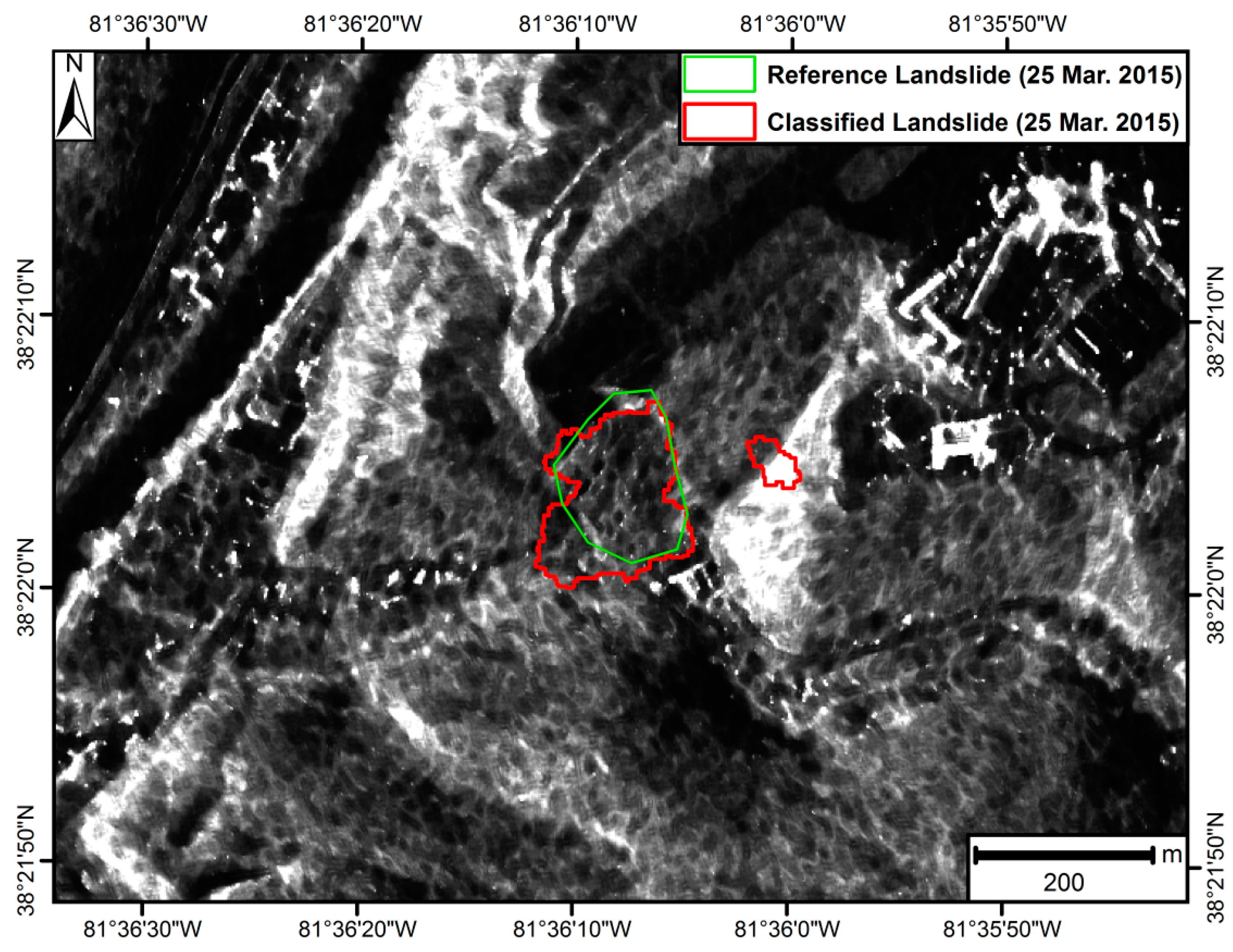
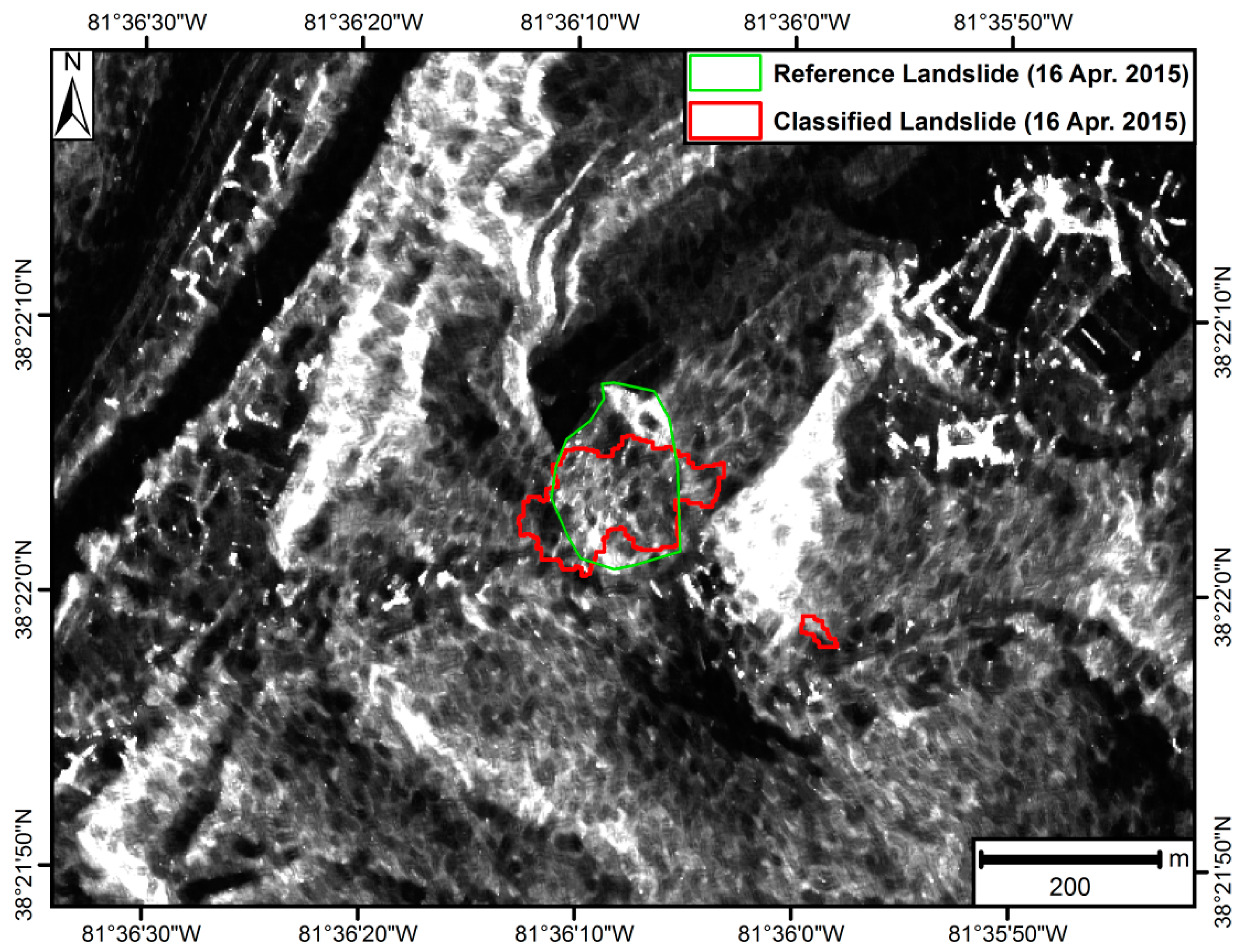
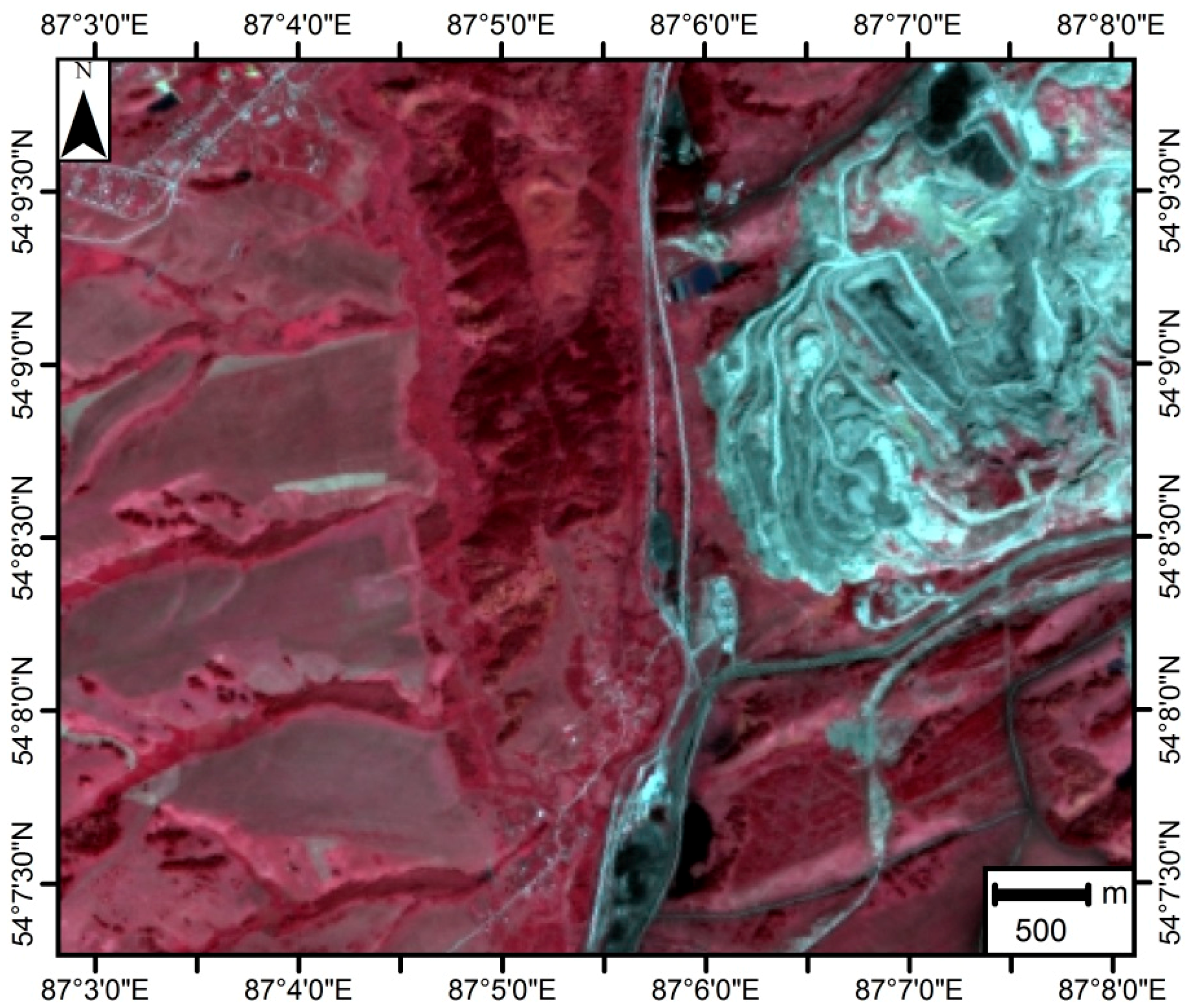
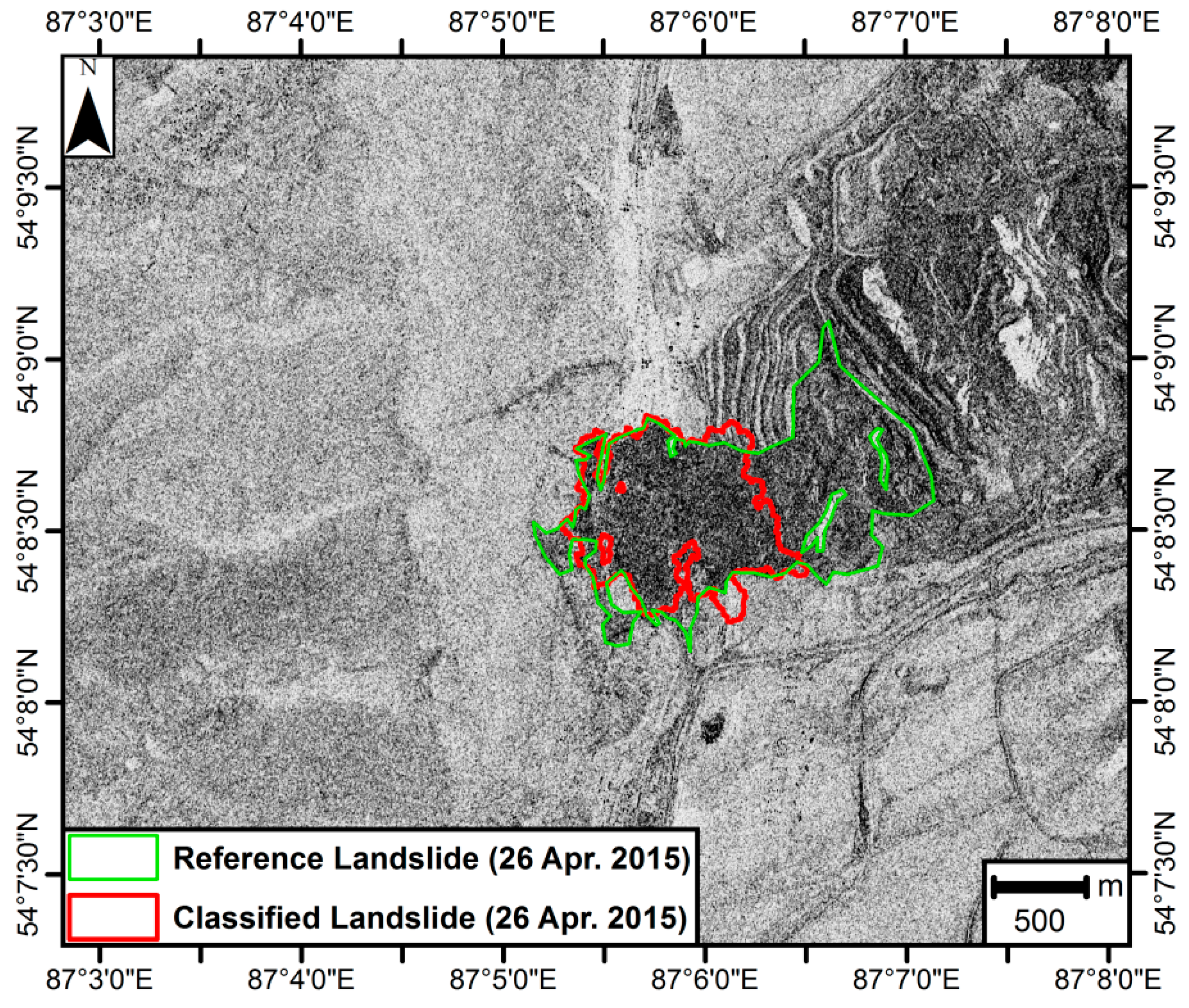
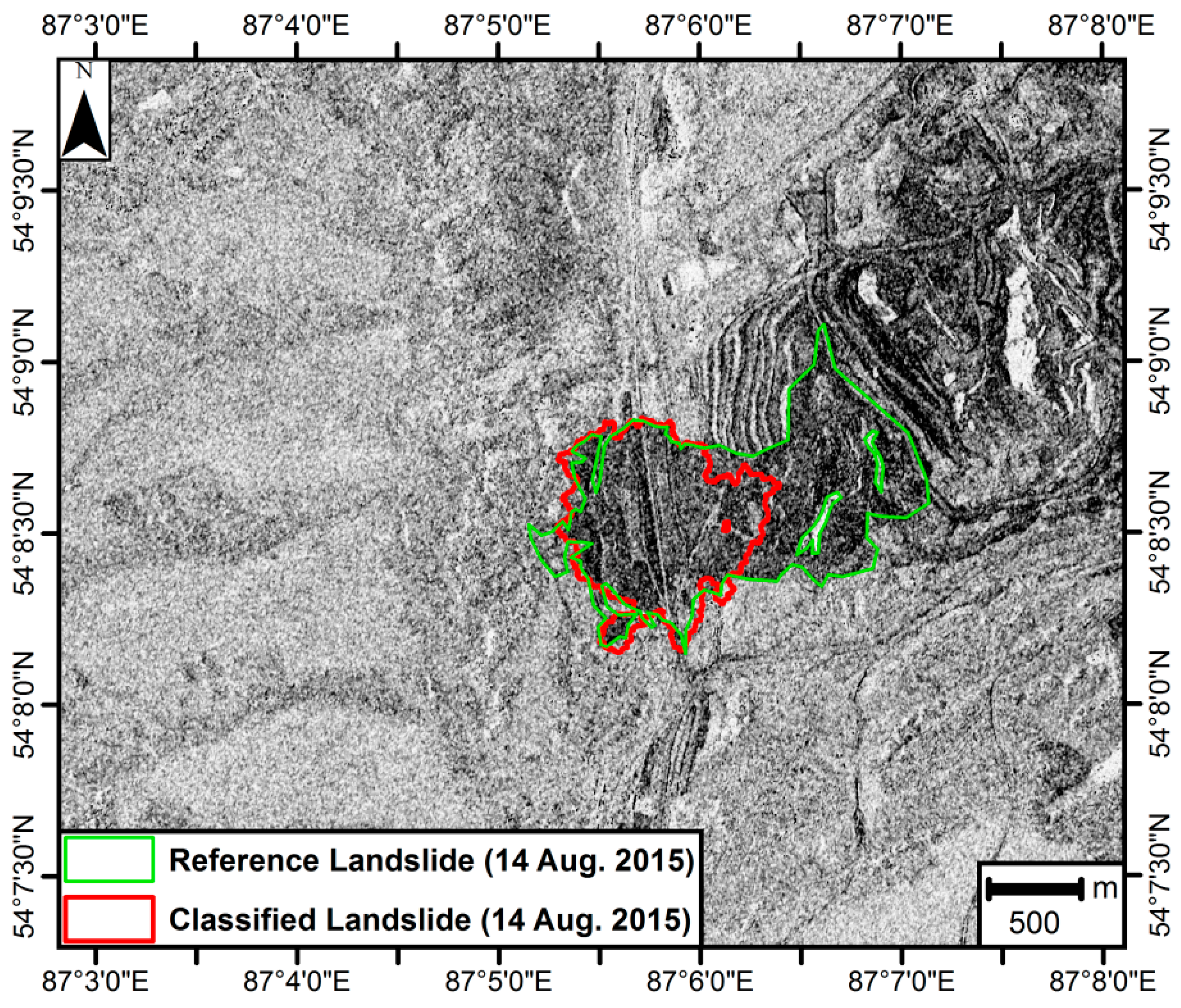
| Study Site | Date of Event | Acquisition Date | Satellite 1 | Relative Orbit 2 | Polarization |
|---|---|---|---|---|---|
| Yeager Airport | - | 2 April 2014 | TanDEM-X | 226/Asc. | HH |
| - | 15 January 2015 | Landsat-8 | 18/33 | - | |
| 1st failure: 12 March 2015 | 25 March 2015 | TerraSAR-X | 44/Asc. | HH/VV | |
| 2nd failure 13 April 2015 | 16 April 2015 | TerraSAR-X | 44/Asc. | HH/VV | |
| Bolshaya Talda | - | 14 September 2014 | Landsat-8 | 146/22 | - |
| 1 April 2015 | 26 April 2015 | TerraSAR-X | 14/Desc. | HH/VV | |
| 14 August 2015 | TerraSAR-X | 14/Desc. | HH/VV |
| Date | OA [%] | PA Landslide [%] | UA Landslide [%] | PA Other [%] | UA Other [%] | KHAT |
|---|---|---|---|---|---|---|
| 25 March 2015 | 99.9 | 87.0 | 67.4 | 99.9 | 100.0 | +0.759 |
| 16 April 2015 | 99.9 | 64.3 | 66.9 | 99.9 | 99.9 | +0.655 |
| Date | OA [%] | PA Landslide [%] | UA Landslide [%] | PA Other [%] | UA Other [%] | KHAT |
|---|---|---|---|---|---|---|
| 26 April 2015 | 96.8 | 48.2 | 89.6 | 99.7 | 97.0 | +0.612 |
| 14 August 2015 | 96.8 | 49.7 | 90.0 | 99.7 | 97.0 | +0.625 |
| Date | OA [%] | PA Landslide [%] | UA Landslide [%] | PA Other [%] | UA Other [%] | KHAT |
|---|---|---|---|---|---|---|
| 26 April 2015 | 98.8 | 83.1 | 76.4 | 99.3 | 99.5 | +0.790 |
| 14 August 2015 | 99.1 | 90.0 | 81.6 | 99.4 | 99.7 | +0.850 |
© 2016 by the authors; licensee MDPI, Basel, Switzerland. This article is an open access article distributed under the terms and conditions of the Creative Commons by Attribution (CC-BY) license (http://creativecommons.org/licenses/by/4.0/).
Share and Cite
Plank, S.; Twele, A.; Martinis, S. Landslide Mapping in Vegetated Areas Using Change Detection Based on Optical and Polarimetric SAR Data. Remote Sens. 2016, 8, 307. https://doi.org/10.3390/rs8040307
Plank S, Twele A, Martinis S. Landslide Mapping in Vegetated Areas Using Change Detection Based on Optical and Polarimetric SAR Data. Remote Sensing. 2016; 8(4):307. https://doi.org/10.3390/rs8040307
Chicago/Turabian StylePlank, Simon, André Twele, and Sandro Martinis. 2016. "Landslide Mapping in Vegetated Areas Using Change Detection Based on Optical and Polarimetric SAR Data" Remote Sensing 8, no. 4: 307. https://doi.org/10.3390/rs8040307
APA StylePlank, S., Twele, A., & Martinis, S. (2016). Landslide Mapping in Vegetated Areas Using Change Detection Based on Optical and Polarimetric SAR Data. Remote Sensing, 8(4), 307. https://doi.org/10.3390/rs8040307





